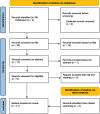Photon-counting CT versus energy-integrating detectors for cardiac imaging: a systematic review of evidence from in vivo human studies on image quality and radiation dose
- PMID: 40713483
- PMCID: PMC12297571
- DOI: 10.1186/s12880-025-01825-8
Photon-counting CT versus energy-integrating detectors for cardiac imaging: a systematic review of evidence from in vivo human studies on image quality and radiation dose
Abstract
Background: Computed tomography (CT) is central to cardiovascular diagnostics, with coronary CT angiography (CCTA) widely used for evaluating coronary artery disease (CAD) due to its high sensitivity and negative predictive value. However, conventional energy-integrating detector (EID) CT is limited by reduced contrast resolution and artifacts, especially in patients with heavy calcification or stents, which can impair diagnostic accuracy. Photon-counting CT (PCCT) is an emerging technology that directly converts X-ray photons into electrical signals, offering improved spatial resolution, contrast-to-noise ratio (CNR), and dose efficiency. While phantom studies have demonstrated its potential, clinical validation remains limited. This systematic review assesses image quality and radiation dose of PCCT versus EID in human in vivo cardiovascular imaging studies.
Methods: A systematic literature search was conducted in PubMed and Embase following PRISMA guidelines. Studies comparing PCCT and EID in cardiovascular imaging in human patients were included. Outcomes of interest were image quality parameters (CNR, SNR, artifacts), subjective image quality, diagnostic confidence, and radiation dose metrics.
Results: Eleven studies met the inclusion criteria, encompassing a range of cardiovascular applications including CCTA, stent assessment, and coronary calcium scoring. Across studies, PCCT consistently demonstrated the potential to improve diagnostic image quality at similar radiation doses, or to maintain the image quality while enabling significant reductions in radiation dose and, in some cases, contrast media volume. Artifact reduction, especially for blooming around calcifications, was frequently reported. However, variation in imaging protocols and outcome measures limited direct comparisons.
Conclusion: Current evidence from human in vivo studies supports that PCCT offers significant advantages in terms of image quality and radiation dose in cardiac CT examinations. Subjective image quality is particularly enhanced, while objective parameters remain influenced by technical factors and protocol selection. While findings are promising, especially for patients with complex coronary pathology, further large-scale, standardized studies are needed to confirm diagnostic and prognostic benefits in routine clinical practice.
Keywords: Cardiac CT; Image quality; Photon counting CT; Radiation dose.
© 2025. The Author(s).
Conflict of interest statement
Declarations. Ethics approval and consent to participate: N/A. Consent for publication: N/A. Competing interests: The authors declare no competing interests.
Similar articles
-
In silico modeling of a clinical photon-counting CT system: Verification and validation.Med Phys. 2025 Jun;52(6):3840-3853. doi: 10.1002/mp.17886. Epub 2025 May 13. Med Phys. 2025. PMID: 40491044
-
Learned high resolution energy-integrating detector CT angiography: Harnessing the power of ultra-high-resolution photon counting detector CT.Med Phys. 2025 Jul;52(7):e17874. doi: 10.1002/mp.17874. Epub 2025 May 8. Med Phys. 2025. PMID: 40344194
-
Denoising pediatric cardiac photon-counting CT data with sparse coding and data-adaptive, self-supervised deep learning.Med Phys. 2025 Jul;52(7):e17918. doi: 10.1002/mp.17918. Med Phys. 2025. PMID: 40660927
-
A systematic review and economic evaluation of new-generation computed tomography scanners for imaging in coronary artery disease and congenital heart disease: Somatom Definition Flash, Aquilion ONE, Brilliance iCT and Discovery CT750 HD.Health Technol Assess. 2013;17(9):1-243. doi: 10.3310/hta17090. Health Technol Assess. 2013. PMID: 23463937 Free PMC article.
-
Systematic review of the clinical effectiveness and cost-effectiveness of 64-slice or higher computed tomography angiography as an alternative to invasive coronary angiography in the investigation of coronary artery disease.Health Technol Assess. 2008 May;12(17):iii-iv, ix-143. doi: 10.3310/hta12170. Health Technol Assess. 2008. PMID: 18462576
References
-
- Wolf EV, Gnasso C, Schoepf UJ, Halfmann MC, O’Doherty J, Zsarnoczay E, et al. Intra-individual comparison of coronary artery stenosis measurements between energy-integrating detector CT and photon-counting detector CT. Imaging. 2023;15(2):61–8.
Publication types
MeSH terms
LinkOut - more resources
Full Text Sources
Medical
Miscellaneous


